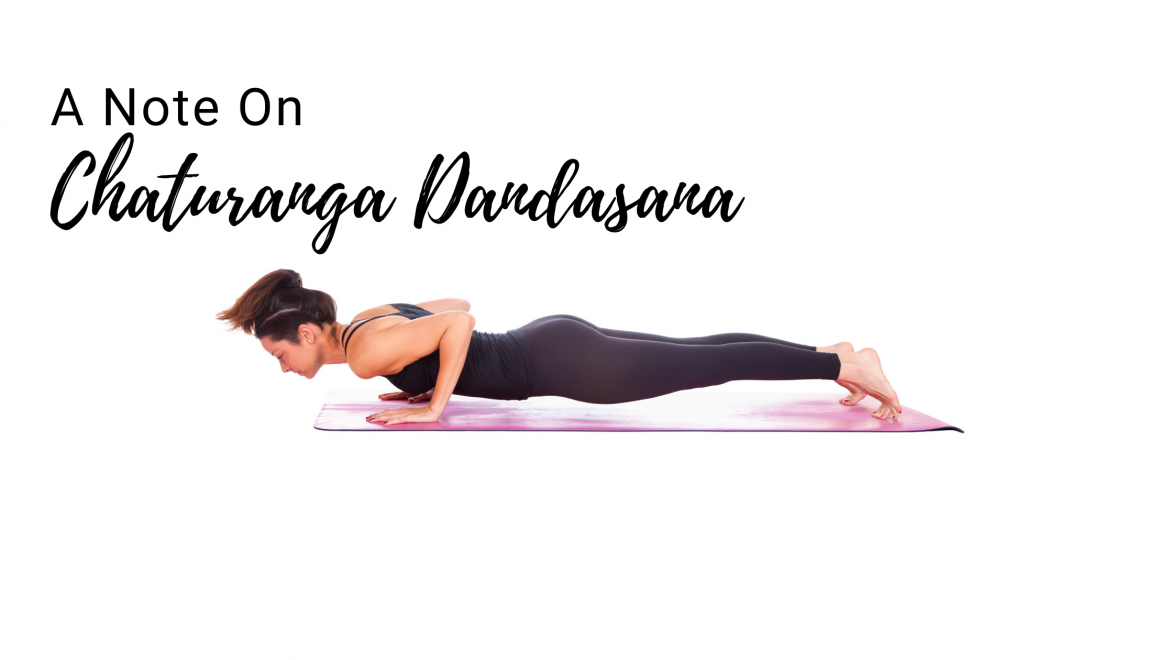Chaturanga Dandasana
Chaturanga Dandasana is a form of asana in modern yoga and all included in some forms of Surya Namaskar (Sun Salutation). In this asana, a straight body is suspended parallel to the ground, whilst being supported by the toes and palms, with elbows at a right angle along the body. The name of this asana is derived from the Sanskrit words “Chatur” meaning “four”, “anga” meaning “limb”, “danda” meaning “staff” and “asana” meaning “posture or seat”. Chaturanga Dandasana has a close resemblance with push-ups, but here the hands are kept quite low (just above the pelvis) and the elbows kept in along the sides of the body. It is a balancing exercise that is said to strengthen the important muscles required for arm balance. This pose can be held for around 30 seconds to one minute, coupled with continuous breathing.

Chaturanga Dandasana is a major component of Astangana, Vinyasa and Power Yoga. When performed correctly, the body resembles a rod or staff, with the spine in one straight line. This asana is said to strengthen the arms and wrists and lower back. It is also said to prepare the body for more challenging arm balances and thereby improves posture. It requires the dedicated practice of the Chaturanga (commonly referred to as to get the pose correctly and avoid any kind of injury. This asana is a powerful body toner. However, it is a challenging pose for beginners as it requires strength, whole-body alignment, and coordination. The pursuit of seeking balance through this pose can teach concentration and focus or dharana. It is an excellent way of connecting to the inner strength and energy. It may challenge those who have a lack of self-belief and enable them to overcome such negative thoughts, as this asana stimulates the manipura chakra, which promotes confidence.
Contradictions of the Chaturanga Dandasana
- People with Carpal Tunnel Syndrome and other wrists,elbow, and shoulder issues should avoid rigorous jumping into and out of the pose.
- Pregnant women or women who are menstruating should avoid this asana completely.
- It is advisable to avoid this asnana if you are finding it impossible to draw and integrate your shoulder blades into your back.
- People who have had shoulder or elbow surgery should also avoid this pose.
- During the performance of the pose, do not let the shoulders fall lower than the elbows.
- Don’t elevate the hips as it may hurt the spine.
Steps for Performing Chaturanga Dandasana
Step 1
Initially perform Adho Mukha Syanasana and then Plank Pose. These are the preparatory poses for Chaturanga Dandasana. Firm your shoulder blades against your back ribs and press your tailbone towards your pubis.
Step 2
With an exhalation slowly lower your torso and legs to a few inches above and parallel to the floor. There’s a back to sway toward the floor and the tailbone to poke up toward the ceiling. Throughout your stay in this position, keep the tailbone firmly in place and the legs very active and turned slightly inward. Draw the pubis towards the navel.
Step 3
It is advisable to keep space between the shoulder blades as wide as possible. Do not bend your elbows to the sides, hold them in by the sides of the torso and push them back towards the heels. Press the bases of the index fingers firmly to the floor. Lift the top of the sternum and your head to look forward.
Step 4
Chaturanga Dandasana is part of the twelve positions of Surya Namaskar. This pose can also be practiced individually anywhere from 10 to 30 seconds. It is required to be released with an exhalation. You can either lay yourself lightly down onto the floor or push strongly back to Adho Mukha Svanasana, lifting through the top of the thighs and tailbone.
Benefits of Chaturanga Dandasana
Core Stability
It is said that balanced core stability prevents damage to the body that may occur due to various body movements. Core stability is important in everyday life as it strengthens the structure of the body and also gives a nice posture, which makes you look good. The Stabilized core is the ability to keep the spine and body balanced. A lack of core stability may cause back injuries, peripheral weakness, joint pain, etc. Chaturanga Dandasana naturally helps the practitioner to attain core stability along with strengthening the core.
Strengthen Arms and Wrists
As this asana requires the practitioners to utilize their shoulders, limbs wrists, and elbows, it makes them stronger. Most people suffer from numerous back and shoulder issues due to an inactive lifestyle. Chaturanga Dandasana can help you to abstain from medicines and operations to keep the back and shoulders in good health. As legs play a pivotal role while performing the asana, the legs are conditioned properly during the practice.
Healthy for Overall Body
The four-limbed staff pose is a boon for physical and mental health. The pose helps in enhancing body strength and flexibility of the major organs of the body like arms, legs, abdomen, etc. It also improves the hunched position and lengthens the spine muscles making it a healthy practice to be adopted. It also has many mental health benefits such as calming the mind, reducing stress, improving the balance of body and mind, etc.
See also: Yogic Breathing and their benefits





Add Comment